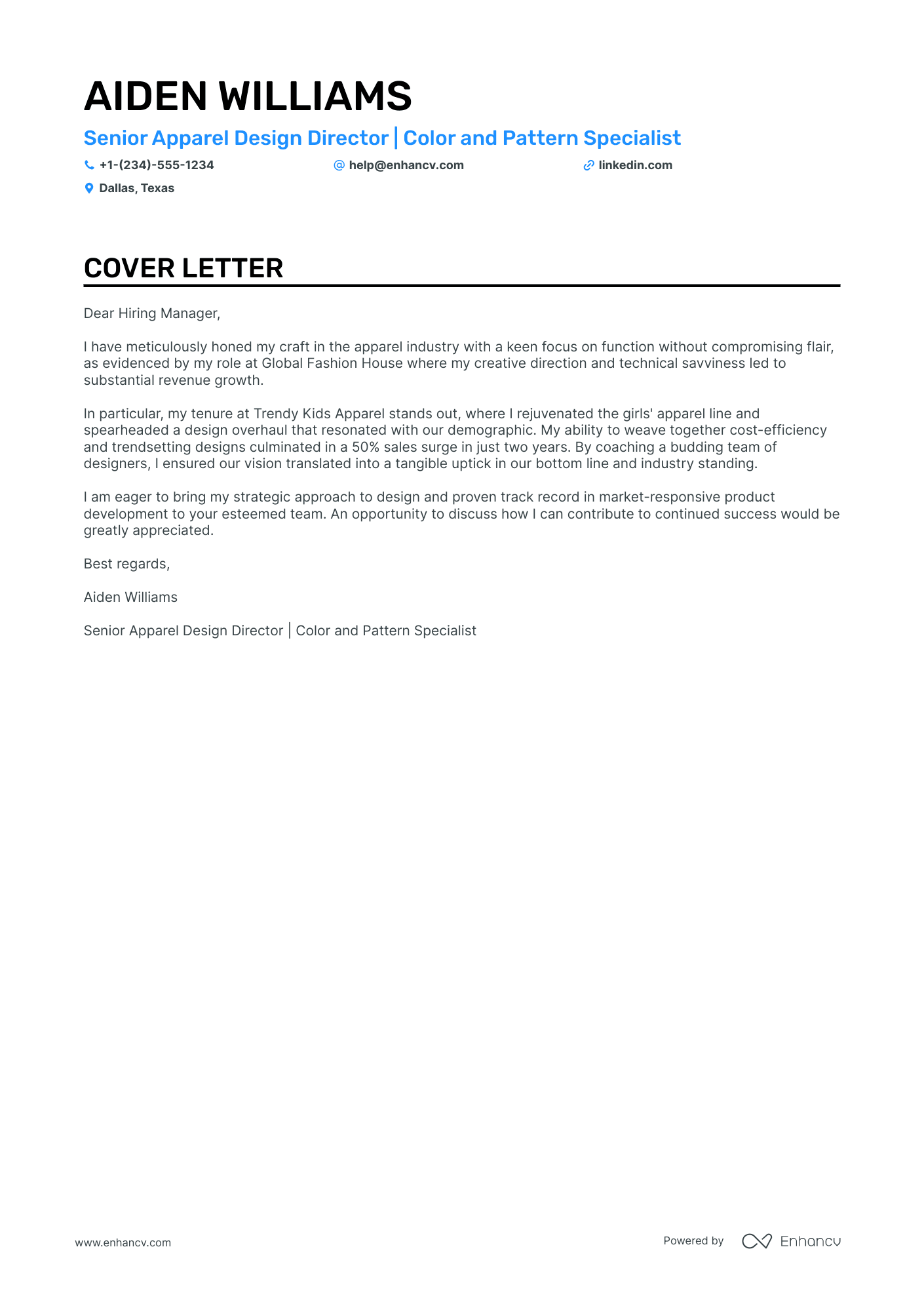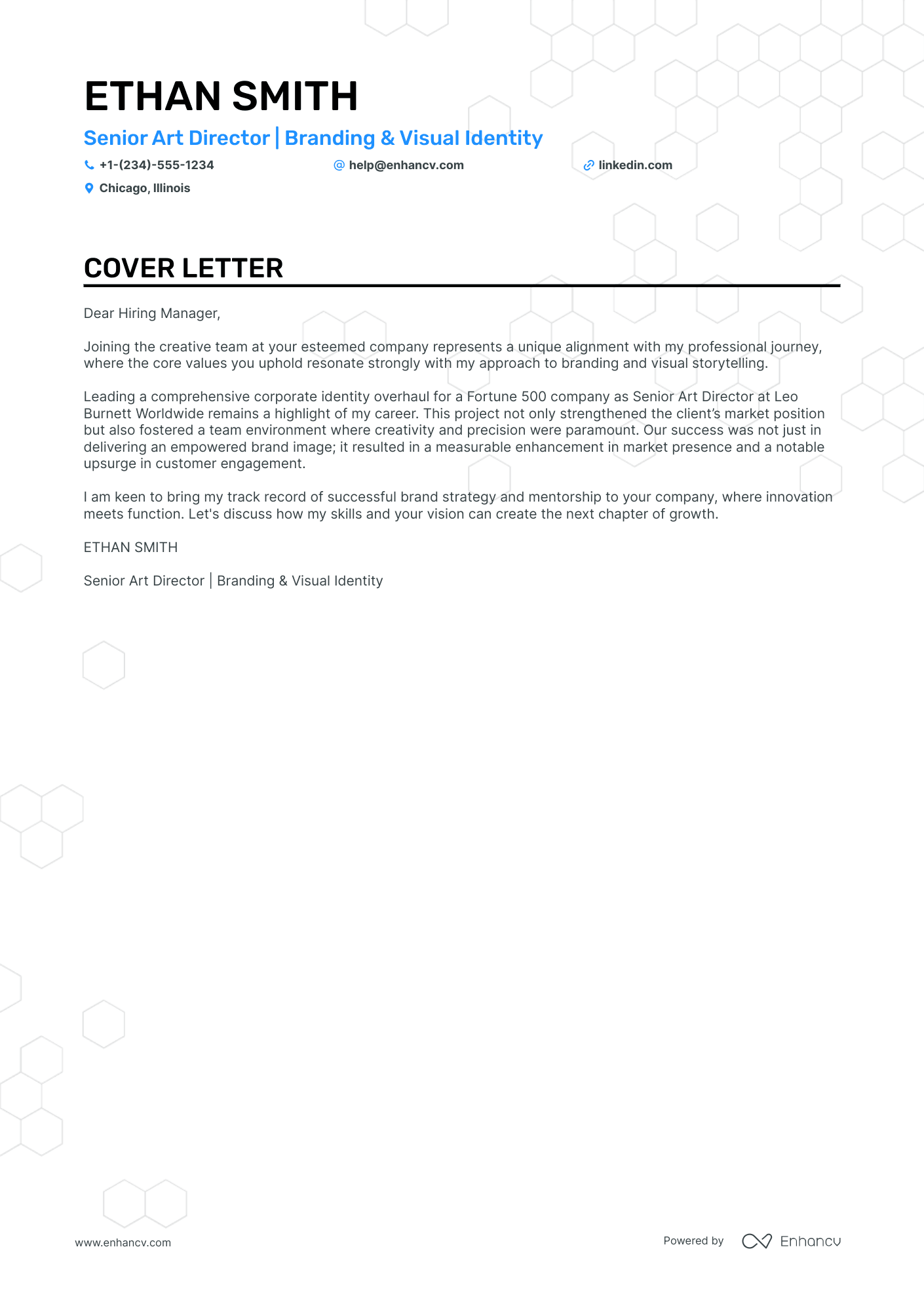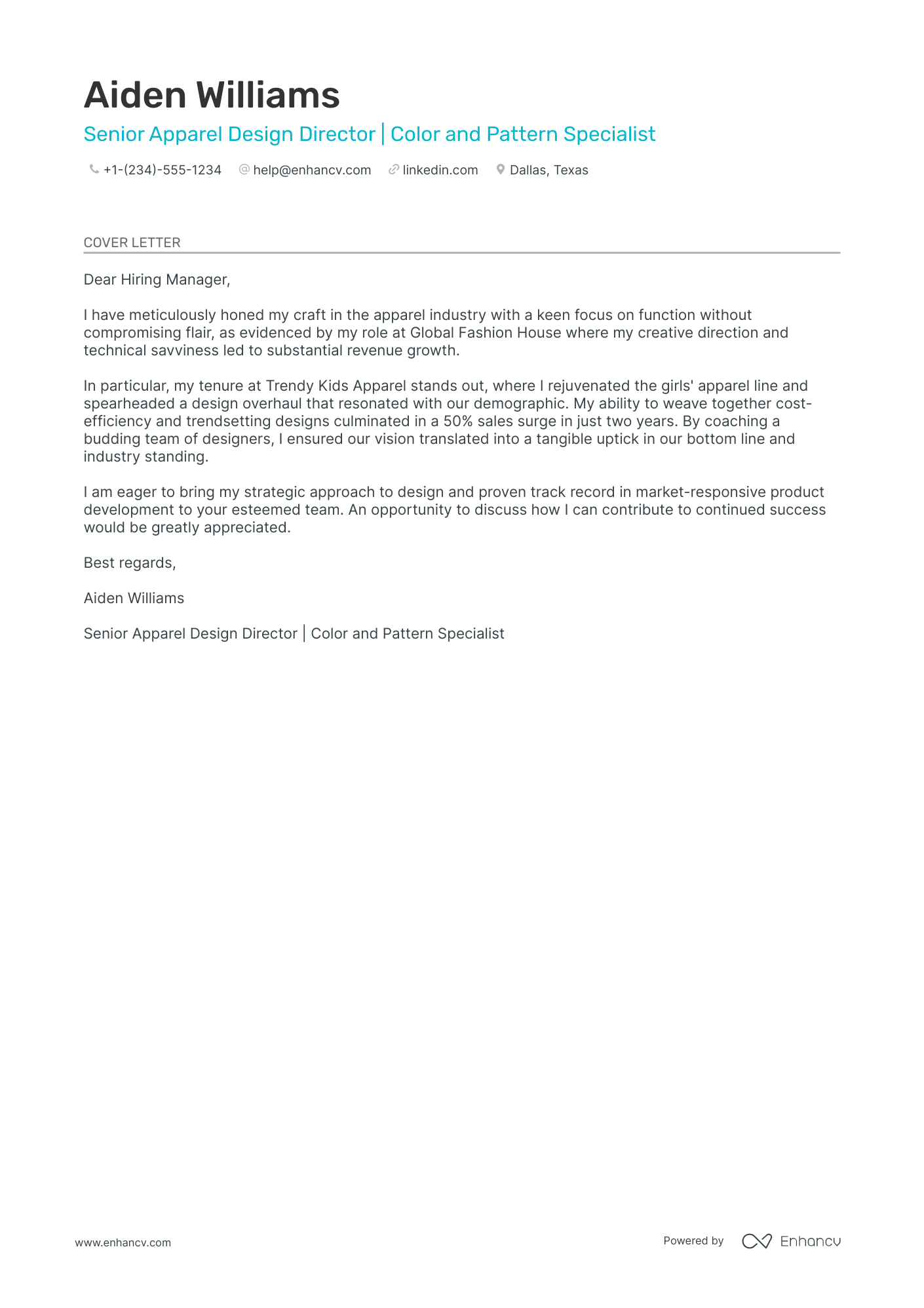As a creative director, crafting a cover letter can be as daunting as starting a new campaign. You’ve polished your resume and started applying for your dream job, but now you face the challenge of distilling your career into a single page without regurgitating your resume's content. Your cover letter needs to be a formal yet unique narrative showcasing your proudest professional achievement. Avoid clichés and aim for impact, ensuring it grabs attention just as effectively as your most compelling work. Let's explore how to create that standout cover letter.
- Personalize your creative director cover letter and get inspired by other professionals to tell a compelling story;
- Format and design your creative director cover letter to make an excellent first impression;
- Introduce your best achievement in your creative director cover letter to recruiters;
- How to make sure recruiters get in touch with you, using your creative director cover letter greeting and closing paragraphs.
What is more, did you know that Enhancv's AI can write your cover letter for you? Just upload your creative director resume and get ready to forward your job application in a flash.
If the creative director isn't exactly the one you're looking for we have a plethora of cover letter examples for jobs like this one:
- Creative Director resume guide and example
- Character Designer cover letter example
- Illustrator cover letter example
- Kitchen Designer cover letter example
- Graphic Artist cover letter example
- Lighting Designer cover letter example
- Interior Designer cover letter example
- User Researcher cover letter example
- Video Production Manager cover letter example
- Cad Designer cover letter example
- Video Editor cover letter example
Drop your resume here or choose a file.
PDF & DOCX only. Max 2MB file size.
Creative director cover letter example
EMMA SMITH
Philadelphia, Pennsylvania
+1-(234)-555-1234
help@enhancv.com
- Highlighting relevant past achievements such as the successful campaign for a AAA title and the impressive milestone pre-sale figure demonstrates experience and success in a similar role, which can be persuasive to potential employers.
- Emphasizing the capacity to blend creativity with business acumen and technological innovation shows a holistic understanding of the role's requirements and indicates that the candidate is results-driven, forward-thinking, and can operate at the intersection of multiple disciplines.
- Mentioning specific metrics such as increasing user engagement by 25% and creative productivity by 30% provides concrete evidence of the candidate's impact and effectiveness.
- Expressing alignment with the company's values and campaigns indicates that the candidate has done their research and is genuinely interested in the company's work, suggesting a good fit culturally and professionally.
The visual appeal of your creative director cover letter: format, font, and structure
When using our cover letter builder, make sure to include these vital sections:
- Header (with your name, contact details, the role, and date);
- Greeting (that's personalized to the recruiter);
- Introductory paragraph (to capture attention);
- Body paragraph (to tell a story of how you've obtained your job-crucial skills);
- Closing paragraph (ending with a nod to the future ahead);
- Signature (that is not a must).
Our cover letter templates are already set up for you with the best creative director cover letter design with single-spaced paragraphs and a one-inch margin.
As for the font of your creative director cover letter, use the same one as you did in your resume (where modern and simple fonts, like Rubik and Bitter, take precedence over Arial and Times New Roman).
Your creative director cover letter is created with the recruiters in mind - as no Applicant Tracker System looks over this part of your profile.
When sending over your creative director cover letter, download it in PDF. This format allows your information and design to stay intact and to keep the same visual quality.
Don’t let a busy schedule hold you back. Try our free cover letter generator and build a great letter in seconds.
The top sections on a creative director cover letter
- Header with Contact Information: Include your name, address, phone number, email, and portfolio link, allowing the recruiter to easily identify and contact you for further discussion or interview scheduling.
- Creative Opening Statement: Start with a compelling hook that showcases your creative flair and relates directly to the creative director role, as it demonstrates your ability to engage an audience from the outset.
- Summary of Creative Experience: Highlight your most significant creative achievements, leadership in managing design teams, and your contribution to successful projects that demonstrate your suitability for the creative director position.
- Explanation of Creative Philosophy: Articulate your unique creative vision and how it aligns with the company's brand or projects, as this shows your potential to be a cultural and creative fit.
- Closing with Call to Action: Conclude with a proactive statement expressing your desire for an interview or discussion, reiterating your enthusiasm for contributing creatively to the company.
Key qualities recruiters search for in a candidate’s cover letter
- Strong portfolio showcasing a variety of creative work across multiple platforms, highlighting the ability to produce visually compelling content with a clear brand narrative.
- Proven leadership experience in guiding and inspiring multidisciplinary creative teams to produce innovative and high-quality work within deadlines and budget constraints.
- Exceptional communication skills, with the ability to clearly articulate creative concepts to stakeholders, clients and team members, ensuring alignment on vision and execution.
- Visionary and strategic thinking, with the talent to anticipate market trends and incorporate them into successful branding and marketing campaigns.
- Solid understanding of user experience (UX) and user interface (UI) design principles, to ensure that all creative output is not only aesthetically pleasing but also user-friendly and effective in driving engagement.
- Extensive experience with project management, including a track record in efficient workflow creation, resource allocation, and cross-departmental collaboration, resulting in seamless project execution.
Personalizing your creative director cover letter salutation
Always aim to address the recruiter from the get-go of your creative director cover letter.
Use:
- the friendly tone (e.g. "Dear Paul" or "Dear Caroline") - if you've previously chatted up with them on social media and are on a first-name basis;
- the formal tone (e.g. "Dear Ms. Gibbs" or "Dear Ms. Swift") - if you haven't had any previous conversation with them and have discovered the name of the recruiter on LinkedIn or the company website;
- the polite tone (e.g. "Dear Hiring Manager" or "Dear HR Team") - at all costs aim to avoid the "To whom it may concern" or "Dear Sir/Madam", as both greetings are very old-school and vague.
List of salutations you can use
- Dear [Hiring Manager's Name],
- Dear [Company Name] Team,
- Dear [Department Name] Hiring Committee,
- Dear [Title of the Hiring Manager],
- Dear [First Name Last Name of the Hiring Manager],
- Dear Hiring Team,
The creative director cover letter introduction: focusing on your unique value, with a creative twist
You are not the only one wondering how to start your creative director cover letter. Those first two sentences introduce your profile and should be memorable.
No pressure.
When beginning your creative director cover letter, immediately point out the unique value of working with you. In other words, what you promise to bring to the role by using your past track record of success.
Start your creative director cover letter with a creative twist by telling a joke or stating something relatable. Select this type of introduction only if it aligns with the company culture.
How to select your best achievement for the middle, or the creative director cover letter body
You probably feel exhausted by this point in your application: you've dived into all the details of your success and skills in your creative director resume.
What else can you include in your creative director cover letter body?
Well, for starters, the next three to six paragraphs should show you further value as a professional. Or, why should recruiters choose you?
Think back on a noteworthy achievement that answers key job requirements and dive deep.
Structure your creative director cover letter middle as you'd a story: following chronological logic and highlighting outcomes, thanks to skills.
At the end of the day, you'd want recruiters to be able to see you as the best candidate for the role and understand more about who you are and what makes your success unique (and valuable to the role).
A sincere and original way to end your creative director cover letter
When writing their creative director cover letter, candidates tend to use one of these phrases, "Sincerely yours" or "I look forward to hearing from you".
Both statements show good manners, but your cover letter should end in a more actionable manner.
Write about:
- how you see yourself growing in the role/organization;
- the benefits you would bring about (you'd impress even more with tangible metrics);
- the next steps in the process (provide your availability for interviews).
Lacking experience: here's how to write your creative director cover letter
As a candidate with no experience, it's important to be honest from the get-go of your application.
Use your creative director cover letter to sell your unique talents. Choose an accomplishment from your academic background or your volunteer work to show the skills that are relevant to the role.
Focus on your career objectives and how you see the job to align with them. Be specific and, at the same time, realistic about where you picture yourself in five years.
Key takeaways
Your creative director cover letter is your best shot at standing out by showing your motivation and the unique skills you'd bring to the job:
- Chose no more than one achievement, which you'd be talking about in the body of your creative director cover letter, by focusing on skills and outcomes;
- Address recruiters with their first or last name, or "Dear Hiring Manager" in your creative director cover letter greeting;
- Introduce in no more than two sentences what makes your profile unique (perhaps it's your motivation, enthusiasm, or appreciation of the company you're applying for);
- Select the same font you have used in your resume (avoid Times New Roman and Arial, as most candidates tend to invest in them);
- Close your creative director cover letter with a promise of how you see yourself growing in the company and the benefits you'd bring about.
Creative Director cover letter examples
By Experience
Senior Art Director
By Role

















